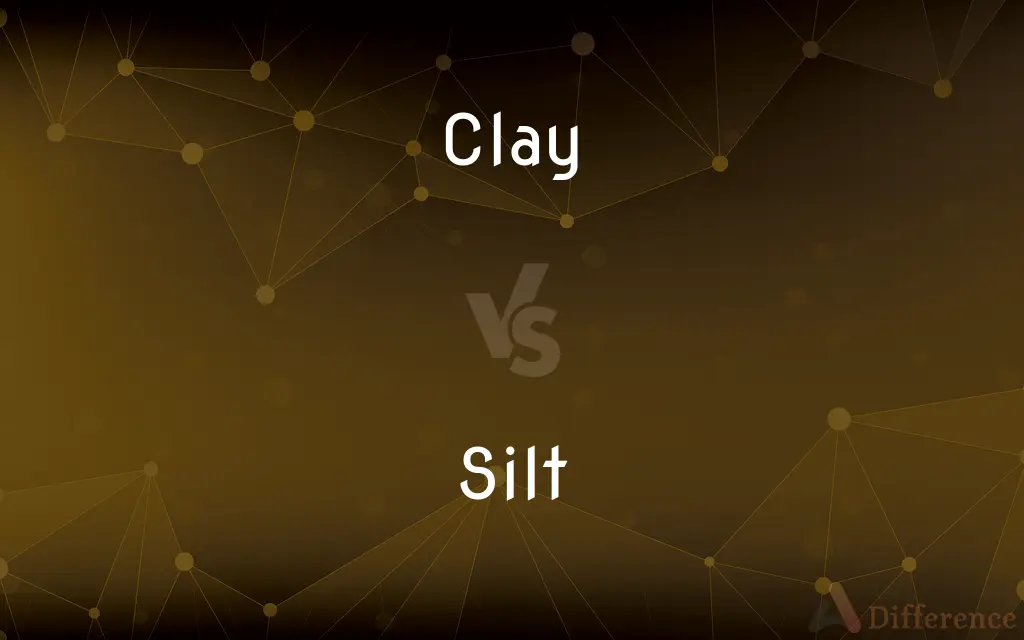Clay vs. Silt — What's the Difference?
Edited by Tayyaba Rehman — By Maham Liaqat — Updated on April 17, 2024
Clay consists of finer particles with a plastic texture when wet, ideal for pottery and construction, while silt features slightly coarser grains, enhancing soil fertility but less plasticity.

Difference Between Clay and Silt
Table of Contents
ADVERTISEMENT
Key Differences
Clay is composed of tiny, often microscopic particles, resulting in a smooth, plastic texture when moist, making it highly suitable for crafting ceramics and bricks. Whereas, silt consists of slightly larger particles than clay, typically under 0.05 mm, which lends a more gritty texture to the touch. This size difference affects their respective uses and behaviors in various settings.
In agriculture, clay soils are known for their capacity to retain water and nutrients well, which can be beneficial for crops that require consistent moisture. On the other hand, silt, with its medium-size particles, provides better drainage than clay and is still fertile, often preferred for cultivating a broader range of plants that require good drainage.
Clay, due to its minute particle size and cohesiveness, is often a major component in construction materials like adobe and pottery, where its plasticity is a crucial property. In contrast, silt, lacking this plasticity, is rarely used in construction but is valued in other areas such as in river deltas where it contributes to fertile soils.
Erosion control is another area where the properties of clay are extensively utilized. Its ability to form dense, water-resistant barriers makes it ideal for ponds and dams. Silt, whereas, is more prone to erosion by water and wind due to its relatively larger particle size and lower cohesion.
Environmental impacts also differ significantly; clay soils can lead to problems like waterlogging and compaction, which hinder plant growth. Silt soils, while still prone to compaction, generally allow better root penetration and air circulation, promoting healthier plant and microbial life in the soil.
ADVERTISEMENT
Comparison Chart
Particle size
< 0.002 mm, very fine
0.002 - 0.05 mm, fine but larger than clay
Texture
Plastic and sticky when wet
Silky and smooth
Drainage
Poor, holds water
Moderate, better than clay
Uses
Pottery, construction, art
Fertile soil for agriculture
Environmental Impact
Waterlogging, compaction
Less compaction, prone to erosion
Compare with Definitions
Clay
Soil with a predominance of clay particles, often challenging for certain types of agriculture due to poor drainage.
The garden’s heavy clay was amended with compost to improve its texture.
Silt
Fine sand, soil, or other material carried by running water and deposited as a sediment.
The riverbanks were lined with silt after the heavy flood.
Clay
As a geological term, clay refers to sedimentary material with particles smaller than silt.
The clay layers in the coastal region showed signs of ancient marine life.
Silt
In environmental contexts, siltation refers to the pollution that occurs when silt accumulates in water bodies.
The lake suffered from severe siltation, impacting the local fish population.
Clay
A natural, earthy material composed of fine-grained minerals with plastic properties when wet.
The artist used a block of gray clay to sculpt a delicate vase.
Silt
As a textural class of soil, silt is identified by its smooth, flour-like feel when dry.
The silt in the flowerbed made it easy for planting small seeds.
Clay
A term used in ceramics to describe the base material used for making pottery.
She teaches how to throw the clay on the wheel to create bowls and plates.
Silt
Soil containing a high percentage of silt particles, known for its fertility and ease of cultivation.
Their farm thrives on the rich silt deposited by the annual floods.
Clay
In construction, clay is used to make bricks, tiles, and other building materials.
The contractor recommended clay tiles for the roof because of their durability.
Silt
Used less commonly in construction, silt is nonetheless important in creating certain types of landscapes.
The landscape architect used the area’s natural silt to enhance the garden’s design.
Clay
Clay is a type of fine-grained natural soil material containing clay minerals. Clays develop plasticity when wet, due to a molecular film of water surrounding the clay particles, but become hard, brittle and non–plastic upon drying or firing.
Silt
Silt is granular material of a size between sand and clay, whose mineral origin is quartz and feldspar. Silt may occur as a soil (often mixed with sand or clay) or as sediment mixed in suspension with water (also known as a suspended load) and soil in a body of water such as a river.
Clay
A stiff, sticky fine-grained earth that can be moulded when wet, and is dried and baked to make bricks, pottery, and ceramics
A clay soil
A clay tile
The soil is mainly clay
The rocks are covered by various mixtures of loose clays and sands
Silt
A sedimentary material consisting of very fine particles intermediate in size between sand and clay.
Clay
A European moth with yellowish-brown wings.
Silt
To become filled with silt
An old channel that silted up.
Clay
A fine-grained, firm earthy material that is plastic when wet and hardens when heated, consisting primarily of hydrated silicates of aluminum and widely used in making bricks, tiles, and pottery.
Silt
To fill, cover, or obstruct with silt
River sediments gradually silted the harbor.
Clay
A hardening or nonhardening material having a consistency similar to clay and used for modeling.
Silt
(uncountable) Mud or fine earth deposited from running or standing water.
Clay
(Geology) A sedimentary material with grains smaller than 0.002 millimeter in diameter.
Silt
Material with similar physical characteristics, whatever its origins or transport.
Clay
Moist sticky earth; mud.
Silt
A particle from 3.9 to 62.5 microns in diameter, following the Wentworth scale.
Clay
The human body as opposed to the spirit.
Silt
(transitive) To clog or fill with silt.
Clay
A mineral substance made up of small crystals of silica and alumina, that is ductile when moist; the material of pre-fired ceramics.
Silt
(intransitive) To become clogged with silt.
Clay
An earth material with ductile qualities.
Silt
(ambitransitive) To flow through crevices; to percolate.
Clay
(tennis) A tennis court surface made of crushed stone, brick, shale, or other unbound mineral aggregate.
The French Open is played on clay.
Silt
Mud or fine earth deposited from running or standing water.
Clay
(biblical) The material of the human body.
Silt
To choke, fill, or obstruct with silt or mud.
Clay
(geology) A particle less than 3.9 microns in diameter, following the Wentworth scale.
Silt
To flow through crevices; to percolate.
Clay
A clay pipe for smoking tobacco.
Silt
Mud or clay or small rocks deposited by a river or lake
Clay
A clay pigeon.
We went shooting clays at the weekend.
Silt
Become chocked with silt;
The river silted up
Clay
(informal) Land or territory of a country or other political region, especially when subject to territorial claims
Danzig is rightfully German clay.
Clay
(transitive) To add clay to, to spread clay onto.
Clay
To purify using clay.
Clay
A soft earth, which is plastic, or may be molded with the hands, consisting of hydrous silicate of aluminium. It is the result of the wearing down and decomposition, in part, of rocks containing aluminous minerals, as granite. Lime, magnesia, oxide of iron, and other ingredients, are often present as impurities.
Clay
Earth in general, as representing the elementary particles of the human body; hence, the human body as formed from such particles.
I also am formed out of the clay.
The earth is covered thick with other clay,Which her own clay shall cover.
Clay
To cover or manure with clay.
Clay
To clarify by filtering through clay, as sugar.
Clay
A very fine-grained soil that is plastic when moist but hard when fired
Clay
Water soaked soil; soft wet earth
Clay
United States general who commanded United States forces in Europe from 1945 to 1949 and who oversaw the Berlin airlift (1897-1978)
Clay
United States politician responsible for the Missouri Compromise between free and slave states (1777-1852)
Clay
The dead body of a human being
Common Curiosities
How does the texture of clay differ from silt when wet?
When wet, clay becomes plastic and sticky, whereas silt feels silky and smooth.
Why is silt more prone to erosion than clay?
Silt particles are slightly larger and less cohesive than clay particles, making them more easily displaced by water and wind.
What are common uses of silt in landscaping?
Silt is used to improve soil fertility and texture in gardens and farms, aiding in better plant growth.
How does the drainage capacity of silt compare to other soil types?
Silt offers moderate drainage, better than clay but less ideal than sandy soils, balancing moisture retention and drainage.
How does the plasticity of clay benefit pottery making?
The plasticity of clay allows it to be easily molded into shapes that harden upon firing, which is essential for pottery.
Are there environmental concerns associated with clay soils?
Yes, clay soils can lead to waterlogging and soil compaction, which can adversely affect plant growth.
What role does silt play in river ecosystems?
Silt deposits can create fertile floodplains and deltas, crucial for agriculture and natural habitats but can also lead to problems like siltation in rivers and lakes.
Is there a significant cost difference in managing clay versus silt soils?
Yes, managing clay soil often requires more amelioration, like adding organic matter to improve its structure, which can be more costly than managing silt.
Can silt be beneficial for any construction purposes?
While not commonly used like clay, silt can be used to stabilize soil and in landscape filling, providing a foundation in areas with proper drainage.
Why might a gardener prefer silt over clay for certain plants?
Silt allows for better drainage and is less dense than clay, making it preferable for plants that require well-drained soil conditions.
What is the significance of clay in construction materials?
Clay is crucial in the manufacture of bricks, tiles, and other building materials due to its ability to form a hard, durable structure when baked.
How do clay and silt soils react to chemical treatments?
Clay soils can be more reactive to chemical treatments due to their negatively charged particles, which can bind with nutrients, whereas silt reacts less intensely.
What are the challenges of working with silt in agricultural settings?
The main challenges include managing its tendency to compact and addressing erosion issues, particularly in wet conditions.
How can one improve clay soil effectively for better usability?
Improving clay soil involves incorporating organic matter, such as compost or manure, to enhance drainage and decrease compaction.
What are the erosion control advantages of clay?
Clay’s cohesiveness helps in creating barriers against water flow, making it excellent for constructing dams and controlling erosion.
How do clay and silt affect the biodiversity of an area?
Clay, being dense and compact, can hinder root growth, affecting plant diversity, while silt, providing better soil structure, can support a wider range of plant and animal life.
Share Your Discovery

Previous Comparison
Admiral vs. Admiration
Next Comparison
Nat vs. PatAuthor Spotlight
Written by
Maham LiaqatEdited by
Tayyaba RehmanTayyaba Rehman is a distinguished writer, currently serving as a primary contributor to askdifference.com. As a researcher in semantics and etymology, Tayyaba's passion for the complexity of languages and their distinctions has found a perfect home on the platform. Tayyaba delves into the intricacies of language, distinguishing between commonly confused words and phrases, thereby providing clarity for readers worldwide.














































